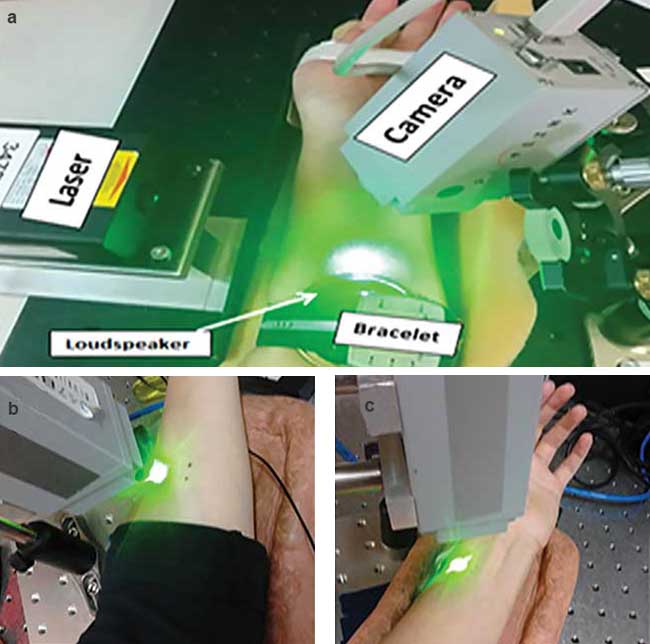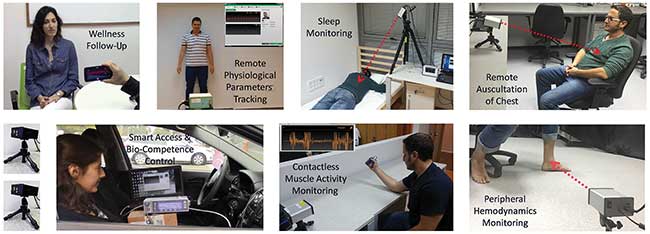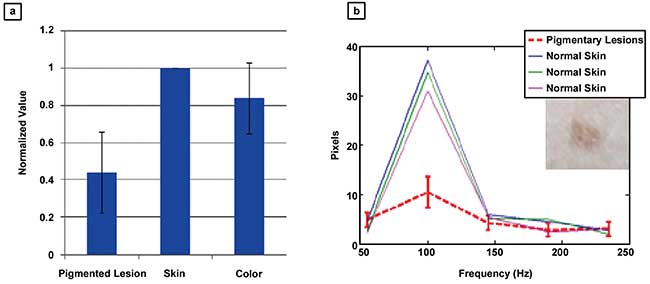Nonimaging optics coupled with artificial intelligence makes sense of nanovibrations to yield a biomedical tool for home care.
Zeev Zalevsky, Bar-Ilan University and ContinUse Biometrics
Photonic-based sensing is an evolving field that provides a large variety of possible biomedical applications for home care diagnosis. Various aspects of light and photons can grant us the ability to create smart sensors based on imaging tools for detecting motion, spectroscopy for detecting the presence of various chemicals (according to their absorption spectra), or even analyzing the properties of spatial distribution of the scattering of light interacting with an inspected tissue.
Typically, these noninvasive light-based diagnostic technologies measure just one characteristic in a sample, such as heart rate, respiration or the amount of saturated oxygen in the blood stream.
One very interesting and new technology involves the use of light to sense the change in the nanovibration profile of skin close to blood arteries. The change in this profile enables the development of a comprehensive understanding of an individual’s medical state by extracting both blood hematology and vital signals, such as respiration, heart rate and blood pressure, an estimate of blood hemodynamics.
“Mechanical” is the first word that comes to mind when speaking of vibrations. However, when the precision of sensing becomes nanometric — a nanometer is the size of a large molecule, and molecules vibrate — the fields of chemistry, medicine and physics all interact. Sensing nanovibrations and applying deep learning, machine learning algorithms to analyze the medical meaning of the change in the vibrational profile is highly informative and can be a meaningful biomedical tool for home care procedures.
A hand-held smartphone device being developed at ContinUse Biometrics — originally commercialized from Bar-Ilan University in Israel and Valencia University in Spain — is designed to monitor heart rate and sound, respiration rate and lung sounds, and blood pressure and levels of stress.
The device takes advantage of nonimaging optics and artificial intelligence to make sense of scattering patterns of light (Figure 1). When a tissue is illuminated with a laser that is temporally and spatially coherent, a self-interference effect generates a random pattern called a secondary speckle pattern (SSP). These patterns have random spatial distribution. If the scattering tissue is moving, the random patterns also will randomly change over time.

Figure 1. Experimental setups. The optical configuration for remote measuring of pigmentary lesion (a). Reference spot of normal skin is positioned under a laser illumination (b). Demonstration of a pigmentary lesion under illumination (c). Images based on figures from reference 3. Courtesy of ContinUse Biometrics.
The concept being deployed at ContinUse Biometrics1 uses a camera with nonimaging optics that performs mathematical transformations over the speckle distribution at the photon level: Six degrees of any general movement can be translated into specific (and not random) predetermined, known changes of the initial SSP. The image-processing algorithms analyze the spatial-temporal changes of the speckle patterns captured by the camera and deduce the nanovibrations that can yield a biomedical diagnosis.
Some biomedical parameters are directly related to the nanovibrational profile, parameters such as heart rate and respiration.
Some are not related directly to the nanovibrational profile, but they can be associated with it. Blood pulse pressure is related to blood pulsation transition time, and transition time can be measured by tracking how the pulsation-related vibration propagates a given distance. Blood hematology can be measured by the effect a given chemical such as alcohol has on the heart rate profile or how a given chemical changes the blood viscosity and affects the blood flow profile (flow is related to vibration).
Some biomedical parameters can be associated with vibrations in a controlled way, for example, by applying external stimulation, such as sonic pressure waves or electromagnetic stimulation, and measuring the effect on the tissue or the chemical. Pressure-based stimulation enables an elastography measurement of an inspected tissue. Electromagnetic stimulation makes it possible to deduce glucose concentration through the Faraday rotation effect that glucose molecules exhibit.
The initial technology is designed for home care and is slated to come to market in Q2 of 2018 (Figure 2). But preliminary research at Bar-Ilan University has already shown some promising new capabilities for the laser-based noncontact biosensor.

Figure 2. Prototypes of ContinUse Biometrics’ remote sensor of multiple bioparameters have been used for a variety of applications. Courtesy of ContinUse Biometrics.
One interesting ongoing research is associated with the capability to perform biomedical diagnosis by remote photonic sensing. Applicable to a large set of medical modalities, this may be done in two stages. First the sensing of the nanovibrations is translated into a set of biomedical parameters (heart rate and sound, respiration rate and sound, blood pressure, etc.) sensed at once, continuously, and by a single sensor. The set of parameters enables medical analytics performed by deep learning algorithms.
One important enhancement to biomedical sensing can be obtained during the speckle-patterns-based sensing by applying external ultra- and infrasonic stimulation. This allows the photonic sensor to sense the responsivity of inspected tissue to external pressure stimulation.
This responsivity is actually the elastography of the volume of the tissue interacting with the laser beam, which is tightly correlated to the exact medical condition of the tissue. When stimulated at infrasonic frequencies of 170 Hz
and 210 Hz, for example, a pigmented lesion has a very different signature/responsivity than normal skin (Figure 3a). The average frequency (temporal frequency of the external infrasonic stimulation) responses of 20 different small pigmented lesions with respect to reference spots after calibration further details the different responsivity of pigmented lesions (Figure 3b).

Figure 3. The average frequency responses of 20 different small pigmented lesions with respect to reference spots after calibration. The responses are measured at stimulated infrasonic frequencies of 170 Hz and 210 Hz (a). One example of signature of skin (elastography) tissue versus the applied external infrasonic stimulation frequency (b). Images based on figures from reference 3. Courtesy of ContinUse Biometrics.
Pigmented lesions are only the first stage of this research and are not a precursor of skin cancer. But if such a significant difference exists in the applied measurement of a lesion, it is a good sign that in case of cancerous tissue the difference will be even greater.
Several interesting medical diagnosis capabilities, which were recently demonstrated and are still in the research stage, involve remote and early detection of diseases highly associated with a change in elastography. In the case of both breast cancer and melanoma2,3, cancerous tissue appearing below the surface of the skin has significantly different elasticity properties than healthy tissue. The cancerous tissue’s volume is so much more rigid and sufficiently different from healthy tissue that a highly sensitive photonic sensor can measure the difference.
Another interesting direction still in the research stage is related to glaucoma, where the sensing procedure applies the external stimulation and sensing to the responsivity of the cornea surface. Changes in this responsivity are directly related to intraocular pressure. When sufficiently high values are shown, this biomedical parameter is directly related to rapid evolution of glaucoma4.
Meet the author
Zeev Zalevsky is head of the electro-optics study program and vice dean at the faculty of engineering at Bar-Ilan University in Ramat Gan, Israel. He is also the director of the university’s Nano Photonics Center at the Institute of Nanotechnology and Advanced Materials, and chief technology officer of ContinUse Biometrics Ltd.; email: [email protected].
References
1. Z. Zalevsky and J. Garcia. Motion detection system and method. US patent No. 8638991; Australian Patent No. 2008278642; South Korean Patent No. 10-2010-7004615; Israeli Patent Application No. 203262; Canadian Patent Application No. 2697625.
2. A. Bennett et al. (2017). Approach to breast cancer early detection via tracking of secondary speckle patterns reflected from the skin with artificial intradermal impurity. Biomed Opt Express, Vol. 8, Issue 12, pp. 5359-5367.
3. Y. Bishitz et al. (2016). Optical configuration of pigmented lesion detection by frequency analysis of skin speckle patterns. Biomed Opt Express, Vol. 7, Issue 3, pp. 1003-1014.
4. I. Margalit et al. (2014). A new method for remote continuous monitoring of intraocular pressure variations. J Biomed Opt, Vol. 19, Issue 2, p. 027002.